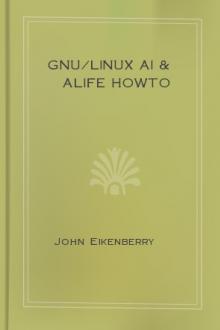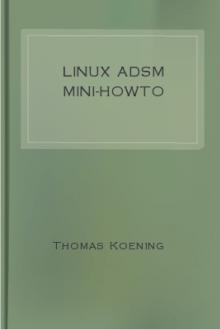GNU/Linux AI & Alife HOWTO, John Eikenberry [best books to read for self development TXT] 📗

- Author: John Eikenberry
- Performer: -
Book online «GNU/Linux AI & Alife HOWTO, John Eikenberry [best books to read for self development TXT] 📗». Author John Eikenberry
GNU/Linux AI & Alife HOWTO
by John Eikenberry
v2.3, 21 Aug 2006This howto mainly contains information about, and links to, various AI
related software libraries, applications, etc. that work on the
GNU/Linux platform. All of it is (at least) free for personal use. The
new master page for this document is http://zhar.net/howto/
–—
Table of Contents
1. Introduction 1.1 Purpose 1.2 What’s New 1.3 Where to find this software 1.4 Updates and comments1.5 Copyright/License
2. Traditional Artificial Intelligence2.1 AI class/code libraries
2.2 AI software kits, applications, etc.
3. Connectionism3.1 Connectionist class/code libraries
3.2 Connectionist software kits/applications
4. Evolutionary Computing4.1 EC class/code libraries
4.2 EC software kits/applications
5. Alife & Complex Systems
5.1 Alife & CS class/code libraries
5.2 Alife & CS software kits, applications, etc.
6. Agents 7. Programming languages8. Missing & Dead
8.1 MIA - Projects missing linkage.
8.2 Dead projects.
–—
1. Introduction1.1. Purpose
The GNU/Linux OS has evolved from its origins in hackerdom to a full
blown UNIX, capable of rivaling any commercial UNIX. It now provides
an inexpensive base to build a great workstation. It has shed its
hardware dependencies, having been ported to DEC Alphas, Sparcs,
PowerPCs, and many others. This potential speed boost along with its
networking support will make it great for workstation clusters. As a
workstation it allows for all sorts of research and development,
including artificial intelligence and artificial life.
The purpose of this Howto is to provide a source to find out about
various software packages, code libraries, and anything else that will
help someone get started working with (and find resources for)
artificial intelligence, artificial life, etc. All done with
GNU/Linux specifically in mind.
1.2. What’s New
� v2.3 -
New entries: “”, “”, “”, “”, “”, “”, “”, “”, “”,
and “”.
Updated information for some entries including “”, “”, “”,
“”, “”, “”, “”, “” and others.
I also changed the MIA section to “” which now groups into
subsections entries with bad links that I can’t find replacements
for and long dead projects.
� v2.2 -
Fixed a some bad links and was forced to move a few entries into
the MIA (missing) section. I also removed one duplicate entry.
New entries: “”, “”, “”, “”, “”, “”, “” and “”.
� v2.1 -
New entries: “”, “”, “”, “”, “”, “”, “”, “”, “”,
“” and “”
� v2.0 - Ran linkchecker and for any bad links I either found a new
link or removed the item. See the new section MIA for a list of the
removed entries (please let me know if you know of a new home for
them).
New entries: “”, “”, “”, “”, “”, “”, “”, “”, and
“”
� v1.9 - One new entry (“”) and fixed the link below to the dynamic
list (now defunct).
� v1.8 - Cleaned up bad links, finding new ones where possible and
eliminating those that seem to have disappeared. Quite a few new
entries as well.
New entries: “”, “”, “”, “”, “”, “”, “”, “”, “”,
“”, “”, and “”
� v1.7 - Another 9 new entries, a bunch of links fixed, and a few
items removed that have vanished from the net.
New entries: “”, “”, “”, “”, “”, “”, “”, “”, and
“UTCS Neural Nets Research Group Software”
� v1.6 - 9 new entries, a couple link fixes and one duplicate item
removed.
� v1.5 - 26 new entries plus a couple link fixes.
� v1.4 - 10 new updates and fixed some lisp-related links.
� v1.3 - Putting a dent in the backlog, I added 30+ new entries today
and submitted it to the LDP.
� Previous records were in a mixed format with site updates. See the
old notes section of the master site for them.
1.3. Where to find this software
All this software should be available via the net (ftp || http). The
links to where to find it will be provided in the description of each
package. There will also be plenty of software not covered on these
pages (which is usually platform independent) located on one of the
resources listed on the links section of the Master Site (given
above).
1.4. Updates and comments
If you find any mistakes, know of updates to one of the items below,
or have problems compiling any of the applications, please mail me at:
jae@zhar.net and I’ll see what I can do.
If you know of any AI/Alife applications, class libraries, etc. Please
email me about them. Include your name, ftp and/or http sites where
they can be found, plus a brief overview/commentary on the software
(this info would make things a lot easier on me… but don’t feel
obligated ;).
I know that keeping this list up to date and expanding it will take
quite a bit of work. So please be patient (I do have other projects).
I hope you will find this document helpful.
1.5. Copyright/License
Copyright (c) 1996-2006 John A. Eikenberry
LICENSE
This document may be reproduced and distributed in whole or in part,
in any medium physical or electronic, provided that this license
notice is displayed in the reproduction. Commercial redistribution is
permitted and encouraged. Thirty days advance notice, via email to the
author, of redistribution is appreciated, to give the authors time to
provide updated documents.
A. REQUIREMENTS OF MODIFIED WORKS
All modified documents, including translations, anthologies, and
partial documents, must meet the following requirements:
� The modified version must be labeled as such.
� The person making the modifications must be identified.
� Acknowledgement of the original author must be retained.
� The location of the original unmodified document be identified.
� The original author’s name(s) may not be used to assert or imply
endorsement of the resulting document without the original author’s
permission.
In addition it is requested (not required) that:
� The modifications (including deletions) be noted.
� The author be notified by email of the modification in advance of
redistribution, if an email address is provided in the document.
As a special exception, anthologies of LDP documents may include a
single copy of these license terms in a conspicuous location within
the anthology and replace other copies of this license with a
reference to the single copy of the license without the document being
considered “modified” for the purposes of this section.
Mere aggregation of LDP documents with other documents or programs on
the same media shall not cause this license to apply to those other
works.
All translations, derivative documents, or modified documents that
incorporate this document may not have more restrictive license terms
than these, except that you may require distributors to make the
resulting document available in source format.
2. Traditional Artificial IntelligenceTraditional AI is based around the ideas of logic, rule systems,
linguistics, and the concept of rationality. At its roots are
programming languages such as Lisp and Prolog. Expert systems are the
largest successful example of this paradigm. An expert system
consists of a detailed knowledge base and a complex rule system to
utilize it. Such systems have been used for such things as medical
diagnosis support and credit checking systems.
2.1. AI class/code libraries
These are libraries of code or classes for use in programming within
the artificial intelligence field. They are not meant as stand alone
applications, but rather as tools for building your own applications.
ACL2
� Web site: www.cliki.net/ACL2
ACL2 (A Computational Logic for Applicative Common Lisp) is a
theorem prover for industrial applications. It is both a
mathematical logic and a system of tools for constructing proofs
in the logic. ACL2 works with GCL (GNU Common Lisp).
AI Kernel
� Web site: aikernel.sourceforge.net
� Sourceforge site: sourceforge.net/projects/aikernel/
The AI Kernel is a re-usable artificial intelligence engine that
uses natural language processing and an Activator / Context
model to allow multi tasking between installed cells.
AI Search II
� WEB site: www.bell-labs.com/topic/books/ooai-book/
Basically, the library offers the programmer a set of search
algorithms that may be used to solve all kind of different
problems. The idea is that when developing problem solving
software the programmer should be able to concentrate on the
representation of the problem to be solved and should not need
to bother with the implementation of the search algorithm that
will be used to actually conduct the search. This idea has been
realized by the implementation of a set of search classes that
may be incorporated in other software through C++‘s features of
derivation and inheritance. The following search algorithms
have been implemented:
� depth-first tree and graph search.
� breadth-first tree and graph search.
� uniform-cost tree and graph search.
� best-first search.
� bidirectional depth-first tree and graph search.
� bidirectional breadth-first tree and graph search.
� AND/OR depth tree search.
� AND/OR breadth tree search.
This library has a corresponding book, “Object-Oriented
Artificial Instelligence, Using C++”.
Aleph
� Web site:
web.comlab.ox.ac.uk/oucl/research/areas/machlearn/Aleph/
This document provides reference information on A Learning
Engine for Proposing Hypotheses (Aleph). Aleph is an Inductive
Logic Programming (ILP) system. Aleph is intended to be a
prototype for exploring ideas. Aleph is an ILP algorithm
implemented in Prolog by Dr Ashwin Srinivasan at the Oxford
University Computing Laboratory, and is written specifically for
compilation with the YAP Prolog compiler
Chess In Lisp (CIL)
� Web site: *found as part of the CLOCC archive at:
clocc.sourceforge.net
The CIL (Chess In Lisp) foundation is a Common Lisp
implementaion of all the core functions needed for development
of chess applications. The main purpose of the CIL project is
to get AI researchers interested in using Lisp to work in the
chess domain.
DAI
� Web site: starship.python.net/crew/gandalf/DNET/AI/
A library for the Python programming language that provides an
object oriented interface to the CLIPS expert system tool. It
includes an interface to COOL (CLIPS Object Oriented Language)
that allows:
� Investigate COOL classes
� Create and manipulate with COOL instances
� Manipulate with COOL message-handler’s
� Manipulate with Modules
FFLL
� Web site: ffll.sourceforge.net
The Free Fuzzy Logic Library (FFLL) is an open source fuzzy
logic class library and API that is optimized for speed critical
applications, such as video games. FFLL is able to load files
that adhere to the IEC 61131-7 standard.
Fuzzy sets for Ada
� Web site: www.dmitry-kazakov.de/ada/fuzzy.htm
� Freshmeat: freshmeat.net/projects/fuzzy/
Fuzzy sets for Ada is a library providing implementations of
confidence factors with the operations not, and, or, xor, +, and
*, classical fuzzy sets with the set-theoretic operations and
the operations of the possibility theory, intuitionistic fuzzy
sets with the operations on them, fuzzy logic based on the
intuitionistic fuzzy sets and the possibility theory; fuzzy
numbers, both integer and floating-point with conventional
arithmetical operations, and linguistic variables and sets of
linguistic variables with operations on them. String-oriented
I/O is supported.
HTK
� Web site: htk.eng.cam.ac.uk
The Hidden Markov Model





Comments (0)